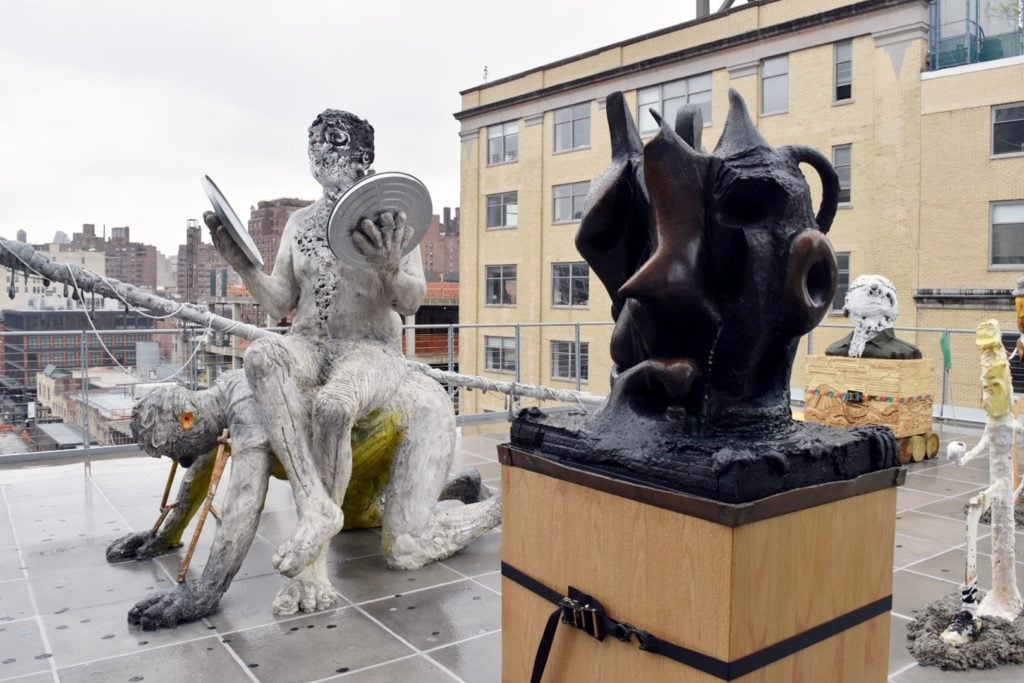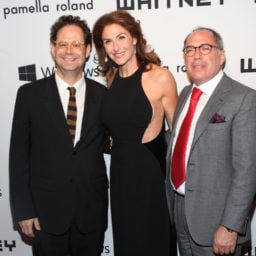This article is being updated to reflect ongoing developments.
Eight prominent artists—Korakrit Arunanondchai, Meriem Bennani, Nicole Eisenman, Nicholas Galanin, Eddie Arroyo, Agustina Woodgate, Christine Sun Kim, and the collective Forensic Architecture—have asked the Whitney Biennial’s curators to remove their work from the current show.
The defections began on Friday, July 19, with a letter that Arunanondchai, Bennani, and Eisenman addressed to the show’s curators, Rujeko Hockley and Jane Panetta, and which was posted to Artforum‘s website.
The letter begins:
We respectfully ask you to withdraw our work from the Whitney Biennial for the remainder of the show. This request is intended as condemnation of Warren Kanders’ continued presence as Vice Chair of the Board. We would appreciate if you presented this letter to the Board to let them know the seriousness of the situation.
The request comes just one day after artists and writers Hannah Black, Ciarán Finlayson, and Tobi Haslett posted an essay, titled “The Tear Gas Biennial,” also on Artforum‘s website. The text reiterated the reasons for opposition to Kanders, due to his ownership of companies that manufacture tear gas and other weapons for the police and military, including tear gas that has been used at the US border against migrants and during protests in Ferguson, Missouri.
In a request for further comment from artnet News, Galanin praised the Artforum essay, but noted that “many of us have been in dialogue regarding Kanders and the Whitney since first learning about his position on the board while profiteering and fueling violence.” He says he hopes this group is “the first… of hopefully many to reject the museum’s inert approach to a serious issue that affects all of our communities.”

Protesters at the Whitney Museum. Courtesy of Decolonize This Place.
In a statement, the Whitney’s director Adam Weinberg confirmed that the museum will remove the works. “The Whitney respects the opinions of all the artists it exhibits and stands by their right to express themselves freely,” he said. “While the Whitney is saddened by this decision, we will of course comply with the artists’ request.”
The “Tear Gas Biennial” essay notes that previous calls for artists to boycott the biennial over Kanders’s connections had been “derided by some as the pet project of just one white woman,” referring to the call’s association with the artist-advocacy group W.A.G.E. But Black, Finlayson, and Haslett dismissed the criticism that demands on artists to withdraw placed “an unfair burden on artists of color, who ought to be celebrated in this majority-minority biennial” or were “an expression of class privilege, because ‘artists must eat.'”
Instead, they revived the call on artists to withdraw in the name of standing with victims of military products sold by Kanders’s company:
Kanders may well be no more malign than many of his peers on boards around the country, and it’s to an extent true that, as people like to say, “all the money is evil,” i.e. capitalist accumulation has as its basis the exploitation, misery, and boredom of people all over the world. But if we believe that our capacity to act against this evil is limited, we should take every opportunity given to us to act.
Until today, the only artist who refused to participate in the Biennial was Michael Rakowitz, who went public with his decision before the show opened. Eisenman, whose sculptures in the show have consistently been spotlighted as one of its highlights, had been making anti-Kanders stickers and handing them out at events during the biennial’s run.
The show also presents a tapestry of a static television screen, White Noise, American Prayer Rug (2018), by Galanin; sculptural video installations featuring interviews with Moroccan teenagers by Bennani; and videos by Arunanondchai as part of its film program.
“We were angry when we learned of Kanders’ role as CEO of Safariland, a company that manufactures tear gas and other weapons of repression,” the letter from Arunanondchai, Bennani, Eisenman, and Galanin states. “At the time, we had already accepted your invitation to participate in the Whitney Biennial and some of us were well into fabrication of major pieces for this show. We found ourselves in a difficult position: withdraw in protest or stay and abide a conflicted conscience. We decided to participate. But the Museum’s continued failure to respond in any meaningful way to growing pressure from artists and activists has made our participation untenable. The Museum’s inertia has turned the screw, and we refuse further complicity with Kanders and his technologies of violence.”
In his statement to artnet News, Galanin elaborated on his motivations:
Does the Whitney want to be complacent in the violence and treatment of people of color in New York City, on our shared boarders and abroad? Do these institutions exist to amplify the artists’ thoughts and perspectives while educating community? Is the Whitney able to do this and bring our community together while neglecting to speak to the violence happening now, or is this something they will proudly celebrate and show in 20 years’ time from a position they have failed to take today? Refusal to take a stand is complacency, especially when you are an American institution with so much influence and voice.
The other three artists who called for the removal of their works did not respond to artnet News’s request for comment by publication time.
UPDATE: According to a New York Times report, artists Eddie Arroyo, Agustina Woodgate, and Christine Sun Kim also demanded their work be withdrawn from the biennial by Saturday morning.
UPDATE: Forensic Architecture, the Turner Prize-nominated research group and art collective led by architect Eyal Weizman, told Hyperallergic that it too had requested to withdraw its biennial work, a video narrated by David Byrne charting the group’s investigation into links between Warren Kanders-connected businesses and human rights violations around the world. Instead, Forensic Architecture has asked that the video, titled Triple Chaser after Safariland’s trademark tear-gas munitions, be replaced by new evidence the group has found directly connecting one of Kanders’s businesses to violence in Gaza on the Israeli-Palestinian border.










